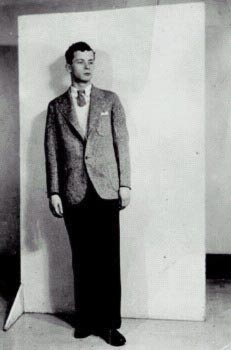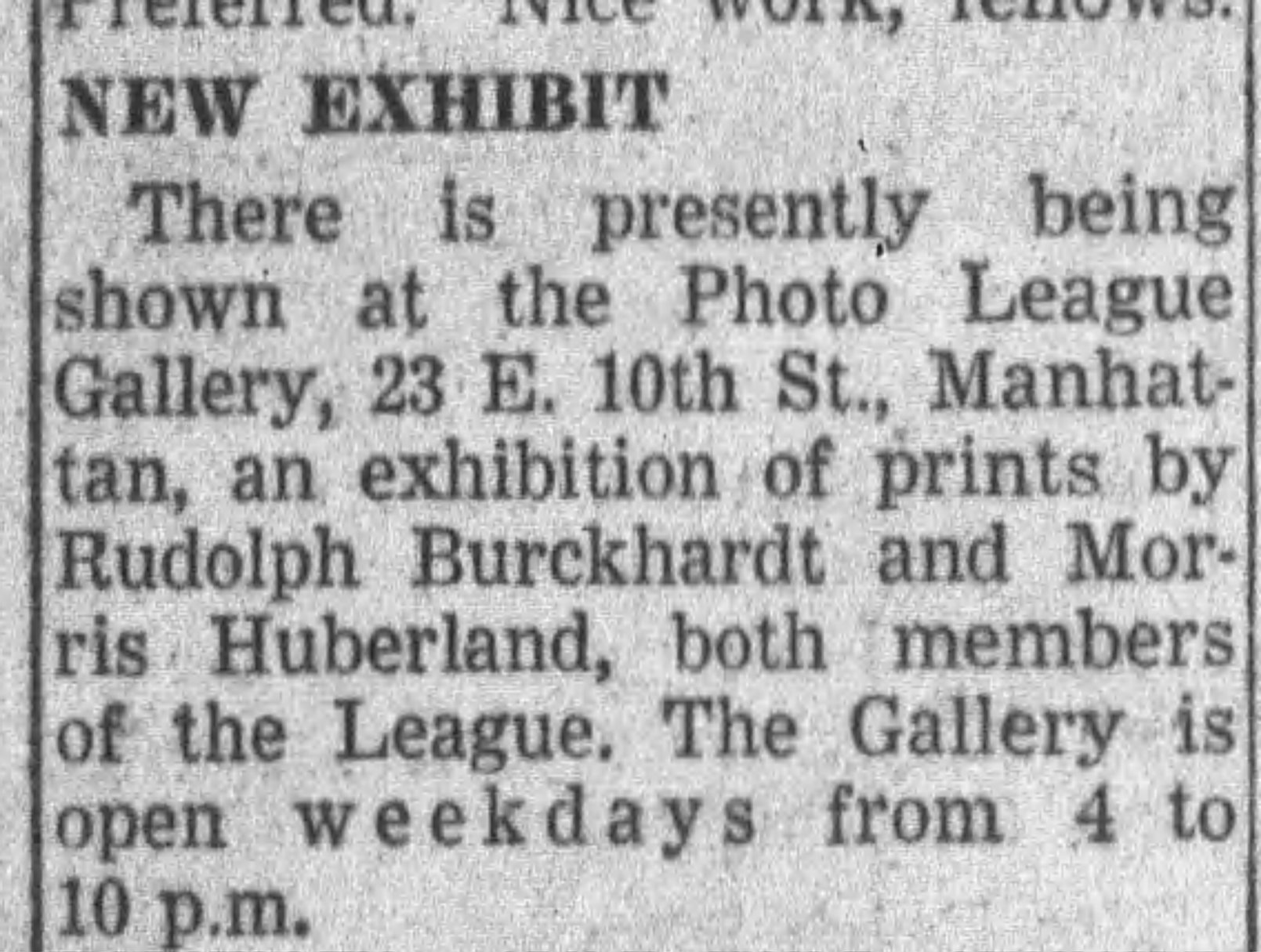Archive
Rudy Burckhardt
- Rudy
- Burckhardt
Rudolph Burckhardt, Rudolf Burckhardt, Rudi Burckhardt
- 06-04-1914
- Basel (CH)
- 01-08-1999
- Searsmont (US)
- PhotographerFilmmakerPainter
Rudy Burckhardt was a Swiss-born photographer, filmmaker and painter who emigrated from Basle to New York City in 1935. He was well networked within the emerging Abstract Expressionist art scene of 1940s' and 50s'.
Word Count: 33

Rudy Burckhardt, Selftportrait, New York 1937 (© VG Bild-Kunst, Bonn 2021). 
Announcement for an exhibition by Rudy Burkhardt at the Photo League Gallery in Brooklyn Eagle, 30 September 1948, p. 18. 
Jaqueline Judge. “Rudi Burckhardt … photographer of everyday life.” Popular Photography, January 1949, pp. 52–53 (Photo: Helene Roth). 
Rudy Burckhardt, Portrait of the painter Willem de Kooning, New York 1937/38 (© VG Bild-Kunst, Bonn 2021). 
Rudy Burckhardt, Building Front Detail with Acanthus Molding in Doorway, New York City, 1938 (© VG Bild-Kunst, Bonn 2021). Burckhardt, Rudy, and Sarah Hermanson Meister. An Afternoon in Astoria and Other Places in Queens (Reproduction of unpublished album of 1943), exh. cat. Museum of Modern Art, New York, 2002. Accessed 7 April 2021.
Burckhardt, Rudy, and Simon Pettet. Talking Pictures. Zoland Books, 1994.
Burckhardt, Rudy. New York, N. Why? Photographs by Rudolf Burckhardt, Poems by Edwin Denby (Reproduction of unpublished album of 1938). Nazraeli Press, 2008.
Casanova, Maria. Rudy Burckhardt. Generalitat Valencia, 1998.
Displaced Visions. Émigré Photographers of the 20th Century, edited by Nissan N. Perez, exh. cat. The Israel Museum, Jerusalem, 2013.
Judge, Jaqueline. "Rudi Burckhardt ...photographer of everyday life." Popular Photography, January 1949, pp. 52–54; 150–151.
Lopate, Philipp. Rudy Burckhardt. Ein Schweizer blickt auf Amerika. AS-Verlag, 2004.
Rudy Burckhardt, edited by Vincent Katz, exh. cat. IVAM Centre Julio González, Valencia 1998.
Rudy Burckhardt – New York Moments: Fotografie und Filme, edited by Haldemann Anita and Hannes Schüpbach, exh. cat. Kunstmuseum Basel, Zürich 2005.
Smith, Roberta. “Rudy Burckhardt, 85, Photographer and Filmmaker, Dies.” The New York Times, 4 August 1999, p. 17. Accessed 7 April 2021.
Venturini, Mary and Edith Schloss. The Loft Generation: Form the De Koonings to Towombly: Portraits and Sketches, 1942–2011. Farrar, Straus and Giroux, 2021.
Word Count: 180
My deepest thanks go to Jacob Burckhardt for providing me with information on his father, Rudy Burckhardt and the VG Bild Kunst for granting me the images rights.
Word Count: 28
New York, US (1935–1999).
145 West 21st Street, Chelsea, New York City (residence and workplace, 1935–1947); 116 West 21st Street, Chelsea, New York City (residence and workplace, 1947–1999).
- New York
- Helene Roth. "Rudy Burckhardt." METROMOD Archive, 2021, https://archive.metromod.net/viewer.p/69/2948/object/5138-11023535, last modified: 16-11-2021.
-
Andreas FeiningerPhotographerWriterEditorNew York
Andreas Feininger, was a German émigré photographer who arrived in New York with his wife Wysse Feininger in 1939. He started a lifelong career exploring the city's streets, working as a photojournalist and writing a large number of photography manuals.
Word Count: 39
Ruth BernhardPhotographerNew YorkRuth Bernhard was a German émigré photographer who lived in New York from the 1920s to the 1940s. Beside her series on female nudes, her place in the photography network, as well as in the New York queer scene, is unknown and understudied.
Word Count: 43
Lisette ModelPhotographerNew YorkLisette Model was an Austrian-born photographer who lived in New York with her husband Evsa Model after emigrating from France. Her street photographs capturing the curiosities of everyday life quickly caught the interest of museums and magazines.
Word Count: 37
Fred SteinPhotographerLawyerNew YorkAlways accompanied by his camera, the German émigré photographer Fred Stein discovered New York City during the 1940s and 1950s. His pictures provide an human and multifaceted view of the metropolis.
Word Count: 31
Charles LeirensPhotographerMusicianMusicologistNew YorkCharles Leirens was a Belgian-born musician and photographer who emigrated to New York in 1941. While publishing two books on Belgian music, he also gave courses in musicology and photography at the New School for Social Research.
Word Count: 36
Rolf TietgensPhotographerEditorWriterNew YorkRolf Tietgens was a German émigré photographer who arrived in New York in 1938. Although, in the course of his photographic career, his artistic and surrealist images were published and shown at exhibitions, his work, today, is very little known.
Word Count: 39
Ellen AuerbachPhotographerNew YorkWhen she arrived in New York in 1937, the German-born photographer Ellen Auerbach (formerly Rosenberg) had already passed through exile stations in Palestine and Great Britain.
Word Count: 25
Ruth JacobiPhotographerNew YorkRuth Jacobi was a German-speaking, Polish-born photographer who emigrated in 1935 to New York, where she opened a studio together with her sister Lotte Jacobi. She later had her own portrait studio.
Word Count: 31
Lilly JossPhotographerNew YorkLilly Joss was an émigré freelance photographer in New York. She worked for the Black Star photo agency and magazines and was also a portrait and theatre photographer.
Word Count: 28
Fritz HenlePhotographerNew YorkFritz Henle was a German Jewish photographer who emigrated in 1936 to New York, where he worked as a photojournalist for various magazines. He also published several photobooks of his travels throughout North America and Asia.
Word Count: 35
T. Lux FeiningerPhotographerPainterNew YorkLux T. Feininger was a German-American émigré photographer and painter and the brother of the photographer Andreas Feininger, arriving in 1936 in New York. Although he started taking photographs during the 1920s in Germany, Feininger is better known for his career as a painter and his photographic work is largely unacknowledged.
Word Count: 50
Service Photo Suppliers Inc.Photo SupplierNew YorkService Photo Suppliers was a photo supplier distributing a wide variety of photo equipment and opened by the German émigré Hans Salomon (1909–?) in 1945.
Word Count: 23
SpiratonePhoto SupplierNew YorkSpiratone was a photo company and photo supplier founded in 1941 by the Austrian émigré family Hans (1888–1944) and Paula Spira (?–?) and their son Fred Spira (1924–2007).
Word Count: 24
Hermann LandshoffPhotographerNew YorkBesides outdoor fashion shots, Hermann Landshoff was a portrait and street photographer. During his time in New York, he captured the cultural, artistic and intellectual émigré scene as well as his photographer colleagues.
Word Count: 33
Marion PalfiPhotographerNew YorkMarion Palfi was a German émigré photographer who lived in New York from the 1940s to the 1960s. Her photographic engagement in social and political topics made her name for her use of the camera to draw attention to social injustices.
Word Count: 41
Mario BucovichPhotographerEditorNew YorkOnly a few details are known of the life and career of émigré photographer and publisher Mario Bucovich, who, after emigrating to New York, published the photobooks Washington D.C. and Magic Manhattan.
Word Count: 33
New School for Social ResearchAcademy/Art SchoolPhoto SchoolUniversity / Higher Education Institute / Research InstituteNew YorkDuring the 1940s and 1950s emigrated graphic designers and photographers, along with artists and intellectuals, were given the opportunity to held lectures and workshops at the New School for Social Research.
Word Count: 31